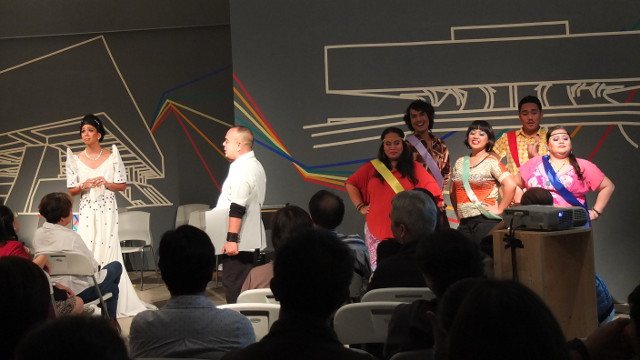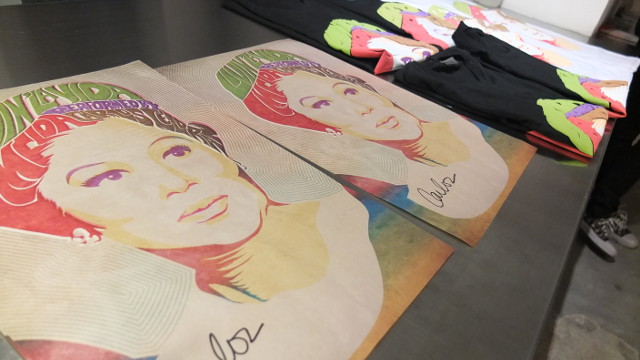SUMMARY
This is AI generated summarization, which may have errors. For context, always refer to the full article.
“EDSA Revolution is not good versus evil.”
These were the words of Carlos Celdran after pulling off a show of “Livin’ La Vida Imelda” at the Silverlens Gallery in Makati last February 22.
The People Power Revolution, which celebrates its 27th anniversary on February 25, 2013, has come to mean many things to Filipinos.
To some, it was the end of Marcos and the beginning of Aquino, the end of a dictatorship and the return of democracy, a sublime demonstration of citizens against human rights abuses.
To others, it was the end of a Golden Age when the Philippines became the second fastest growing economy in Asia. It was the end of the reign of a new brand of national leadership and the return to power of the old landed elite.
Provocative history
In his supremely entertaining show, Celdran accommodates all of these perspectives and more.
As host, narrator, demonstrator, and lead provocateur — accompanied by a plastic-M16-weilding chorus in ’60s mod outfits — he tells the story of the Filipino people by focusing on his sometimes comical, sometimes tragic but always resilient heroine: Imelda Romualdez Marcos.
He navigates through history’s labyrinths, much like the heritage tour guide all know him to be, with the aid of a projector, video, costumed actors, and his trusty grey clearbook which he uses for both visual and aural emphasis.
Audiences begin the journey with a short introduction to the Philippines, the setting of all the mayhem and drama.
The journey then branches off from the main road and leads you to a flowery alley where you meet Imelda Romualdez, the young daughter of a dark-skinned mother who was unfairly treated by her husband’s first family.
Because of this, young Imelda “slept on cardboard behind the family’s Cadillac” and ate pan de sal without any palaman (filling), all this within walking distance of the Malacañan Palace in the San Miguel District where she spent her early years.
Her family then moved to Leyte, her father’s home town, where Imelda spent the rest of her childhood swimming in rivers and winning beauty pageants.
Who knew this beautiful probinsyana would grow up to be the extravagant First Lady who partied with Hollywood celebrities, built edifices that rose and crashed, bought thousands of shoes, and even earned herself a nomination for the Nobel Peace Prize?
With a wicked smile, several costume changes (each to signify a new chapter in the Imelda saga) and pauses for effect, Celdran colors the presentation with juicy bits of gossip and personal anecdotes (don’t miss his retelling of when he was first introduced to “Madam”).
His performance is mostly light and entertaining, seamlessly weaving in jokes and “are you serious?” moments. But he is somber and poignant at appropriate times such as the retelling of the human rights abuses that stained Marcos’s rule beyond redemption.
Of demons and angels
But the main thesis of his show is that we must resist the temptation to over-simplify the Marcos era and the EDSA Revolution as a battle between good and evil.
“One has to realize that [between] Marcos and Aquino, nobody is bad and nobody is good… Don’t polarize. Don’t look at the EDSA Revolution as hate. Don’t look at it as black and white,” he says.
“EDSA Revolution is all about realizing all these things occur within us simultaneously, that repression and expression are all part of the same personality.”
This idea runs through every element of his show. In between the smart jabs and fun pokes, he takes time to explain even the side of the demonized Marcoses.
Imelda’s extravagance may have been sourced from public funds, but Carlos explains that everything Imelda did then — from flying Hollywood celebrities and politicians first-class to throwing big parties to having grass painted green in time for Miss Universe — was all for her dear Philippines.
Alongside Ferdinand Marcos’s many pitfalls, Carlos showed his achievements and a hint of what the country could have been if the president had not lost his way.
Lessons still to be learned
So if the EDSA Revolution is not about good winning over the bad, why should we celebrate or remember it?
Celdran says, “The only reason why we should believe in EDSA [Revolution] is because it is the purest form of our belief in freedom.”
“Even if Ferdinand Marcos and Ninoy Aquino may have been two polarizing factors, the two things that they believed in was freedom.”
This belief could have taken the form of Ninoy fighting for the return of civil rights and, though in a skewed way, in Marcos’s belief in the New Society.
And what about Imelda?
“For us to blame her for everything that happened is rather unfair because we created her. We projected our desires on her,” says Celdran.
“Imelda would not exist without us.”
She wooed us, she sang to us, and millions adored her. This may explain why the Marcoses stayed so long in power.
The majority of the populace may have indeed believed that she represented “the true, the good, and the beautiful.”
Let Imelda remind us of our dangerous tendency to create personas and illusions out of our country’s leaders. May we not fall into the same trap.
The approaching May 2013 elections can be an opportunity to learn from our past mistakes. – Rappler.com
(Carlos Celdran’s “Livin’ La Vida Imelda” runs until March 16 at the Silverlens Gallery, Pasong Tamo Extension, Makati City. For tickets, call 816-0044.)
Add a comment
How does this make you feel?



There are no comments yet. Add your comment to start the conversation.